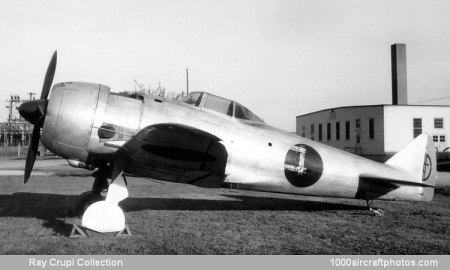11/30/2010. Denoting radical rethinking on the part of the Imperial Army in being a dedicated interceptor with the emphasis on speed at some expense to maneuverability, the Ki-44 was first flown in August 1940. Three prototypes were built with Nakajima Ha-42 engines rated at 1,250 hp at 13,125 ft (4000 m) and each armed with two 0.303 in (7.7 mm) and two 0.50 in (12.7 mm) machine guns. Seven pre-series aircraft followed and these, together with two of the prototypes, underwent operational trials in China from late 1941.
A further pre-series batch comprising 40 aircraft was built, these being designated Ki-44-Is (the Ki-44-I-Ko having an armament of four 0.50 in (12.7 mm) machine guns and the Ki-44-I-Hei having a relocated oil cooler and main wheel fairing doors). In September 1942, the Ki-44 was officially adopted, by which time five prototypes and three pre-series examples of an improved version, the Ki-44-II, were under construction. These were powered by the two-stage supercharged Nakajima Ha-109 engine providing 1,520 hp for take off, and featured pilot armor and fuel tank protection.
The initial series Shokis (Devil-Queller) were designated Ki-44-II-Ko and carried two fuselage-mounted 0.303 in (7.7 mm) and four wing-mounted 0.50 in (12.7 mm) machine guns. These were delivered late in 1942, but an armament of twin fuselage-mounted and twin wing-mounted 0.50 in (12.7 mm) weapons was subsequently standardized for the Ki-44-II-Otsu, while the
Ki-44-II-Hei replaced the wing-mounted machine guns with 0.787 in (20 mm) cannon.
The principal production version was the -II-Otsu and manufacture was phased out late in 1944 after delivery of 1,167 Ki-44-IIs, a final variant, the Ki-44-III, having proved unacceptable. This, powered by a Nakajima Ha-145 engine rated at 2,000 hp for take off, had a 26.6% increase in wing area to 204.52 sq.ft (19 sq.m) and a larger tail. The first prototype was completed in June 1943, and evaluation examples with differing armament arrangements were built, comprising four 0.787 in (20 mm) cannon or (Ki-44-III-Ko) two 0.787 in (20 mm) and two 1.46 in (37 mm)
cannon.
